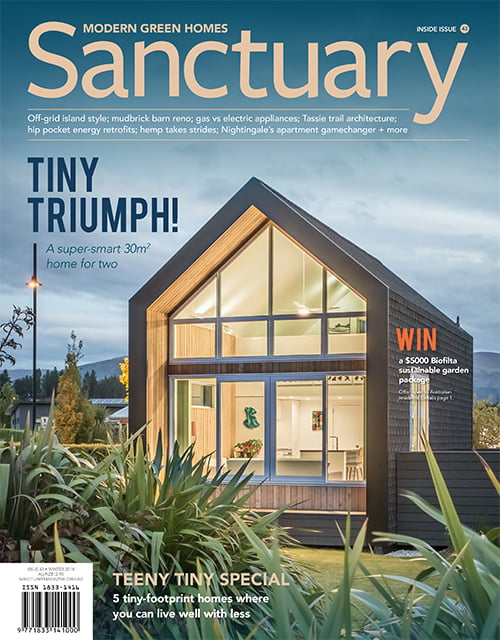Hemp, hemp masonry and hempcrete

Hemp masonry is gaining recognition as a high-performance, low-impact and contemporary building product. Building designer and hemp proponent Dick Clarke explains how it’s best used in housing and its role in regenerating local agriculture.
The advantages of building with hemp are so many and varied it’s hard not to get excited about it. It does great things to the performance and livability of the building, it is kind to the world in its processing, and it is one of those super-crops1 that is part of the regenerative farming revolution.
Its importance to Australia’s long-term ecological sustainability is hard to overstate, and for that reason it is worth looking closely at its production benefits, so we can understand how beneficial it is before it even gets to our building site. Then the outstanding performance in the building makes it undeniably a front contender in many types of building projects.
It can be used in several ways in building, and goes by several names, such as ‘hemp-lime composite’, ‘hemp masonry’, ‘hempcrete’, and simply ‘in situ hemp’. Industrial hemp is bred from certified low-THC varieties of hemp which have grown for thousands of years throughout Europe and Asia. Its closest botanical relative is hops. Let’s start by looking at the beginning of its supply chain, then at how it works in the built form.
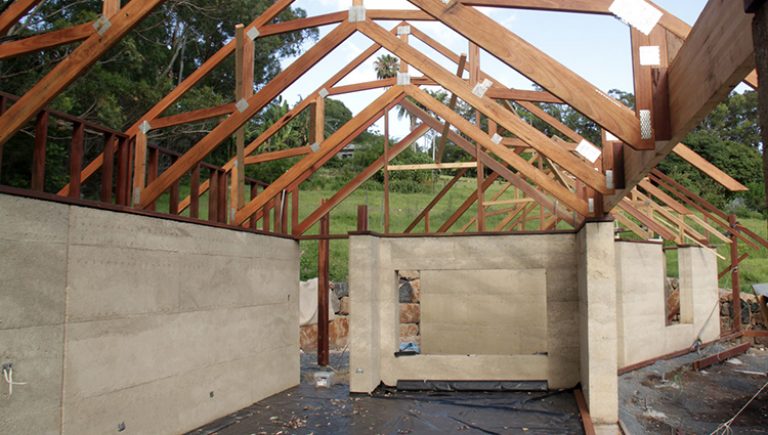
Farming
The emerging regenerative farming movement has found ways of growing traditional annual grain crops like wheat in conjunction with native pastures and even intense short rotation grazing.2 This is done in ways that restore whole ecosystems, from soil biota and productivity right through to agroforestry and full biodiversity. Few crops are grown in Australia with as much benefit to the land as hemp. It is a short cycle crop and can complement any farming regime, having no-till sowing (that is, no preparatory plowing), acting as a great nitrogen fixer, and requiring no fertiliser or herbicide, and little or no irrigation, depending upon the climate zone. When harvested, the roots are left undisturbed in the ground, rotting away to help compost and revitalise the soil. One hectare produces between 10 and 15 tonnes of biomass in a growth cycle of three to four months.
Harvesting yields in Australia are generally between 12 and 15 tonnes per hectare, but in a trial in Bangalow NSW, one hectare was irrigated with tertiary treated effluent water and produced a spectacular 22 tonnes! Yields are dependent on multiple factors including the cultivar planted, its origin, the quality and friability of the soil, sufficient nutrients and availability of irrigation or rainfall. It grows very rapidly, over four metres in less than a hundred days, and is one of the most efficient carbon dioxide-to-biomass conversion tools available, being five times more efficient than agro-forestry.
In conventional industrial agriculture, the tractor is put on the paddock repeatedly, plowing (which opens up the deeper soil to moisture loss), scarifying (which was always a pointless exercise, turning good soil into dust), spreading fertiliser (upsetting the natural soil microbes), spraying herbicide to control weeds, and pesticides to control pests, both of which kill all the helpful plants and microbes and pest-controlling insects. The fuel and chemicals bill in a bad year would wipe out any profit many farms make, and even in good years chewed up an unwelcome portion. Hemp farming offers a good cash return at the farm gate without the big overheads, which is of enormous economic benefit not just to the farmer, but to the communities they are part of. The reduced sales by farm suppliers is a slight downside in the short term, but most of the money went to multi-national chemical and oil companies
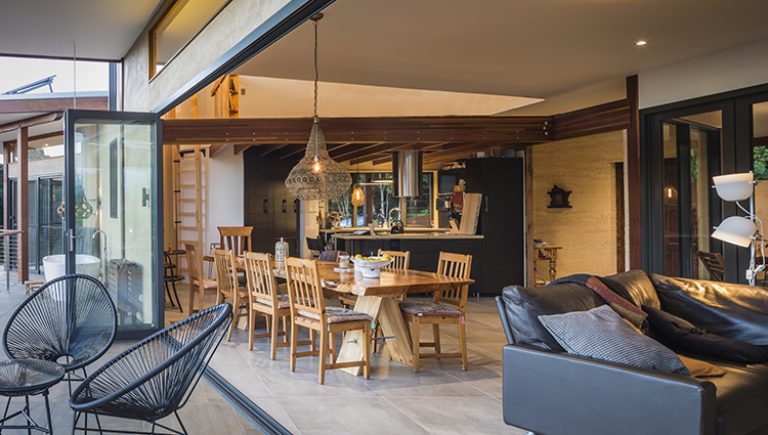
Carbon farming and pollution remediation
Carbon sequestration in agriculture is an important emerging component of our toolkit meeting our international and moral obligations in emissions reduction. According to European research, where hemp is sustainably farmed nearly two kilograms of carbon dioxide is stored per kilogram of hemp fibre harvested. It’s still early days in the creation of a soil carbon methodology for hemp in Australia, but UK data has confirmed that hemp production sequesters one tonne of soil organic carbon per hectare.
Hemp-lime masonry locks up the captured carbon, to form a carbon sink. The building material then continues to take carbon dioxide out of the atmosphere as it slowly cures through the carbonation process. Industrial hemp also has the capacity to clean up contaminated soils. European research3 has demonstrated that hemp can be grown on soils contaminated with heavy metals, while the fibre remains virtually free of the metals. Australia therefore has a huge opportunity to leverage carbon storage in a way that also regenerates our soil and broader ecosystems.
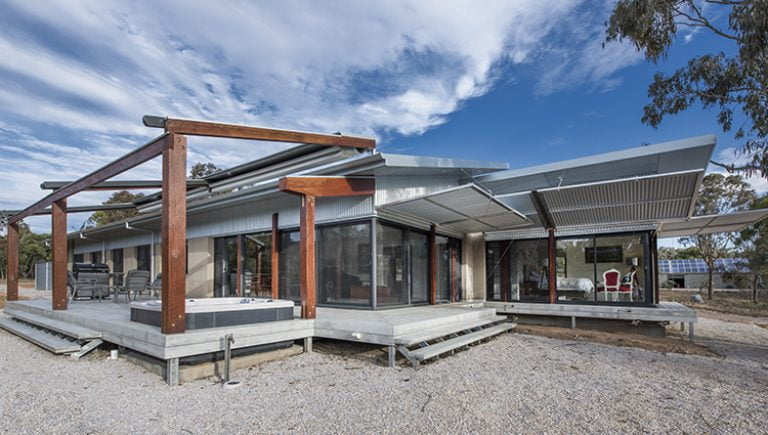
Processing
Once harvested, the hemp crop produces three kinds of ingredients, each with multiple uses. The seed is useful for future cropping, but also has great nutritional characteristics, and is becoming a mainstream ingredient in various foodstuffs and recipes. The leaf is left in the paddock where it contributes significantly to the nitrogen returned to the soil. The long woody stem is comprised of two materials: an outer layer of strong fibrous material called bast. This is where hemp gained its historical fame, in rope making. Without hemp fibre, rope as we know it would not have been possible, and thus sailing ships, and cranes, and weaving would not have been part of our history – and the world would be a very different place. Nowadays, it is also used in the production of such things as interior door and roof panels by carmakers such as Mercedes Benz.
The component of the stem that is of interest to us designers and builders is the chunky woody stuff from the stem, known as hurd. This is crushed to predetermined sizes, much like aggregate in any other concrete mix. It is lightweight, high volume, usually shipped in 10kg sealed bags. Australia has a few fixed and mobile processing plants, in Dungog and Gippsland, with more coming online soon in Victoria, Queensland and Western Australia. It is a low energy process involving only shredders and crushers, with no added heat, thus adding little embodied carbon to the end product. It is preferable to have a regional connection between growers, processors, and end users, to reduce the transport impacts of moving this low mass, high volume product, which invariably relies on trucking.
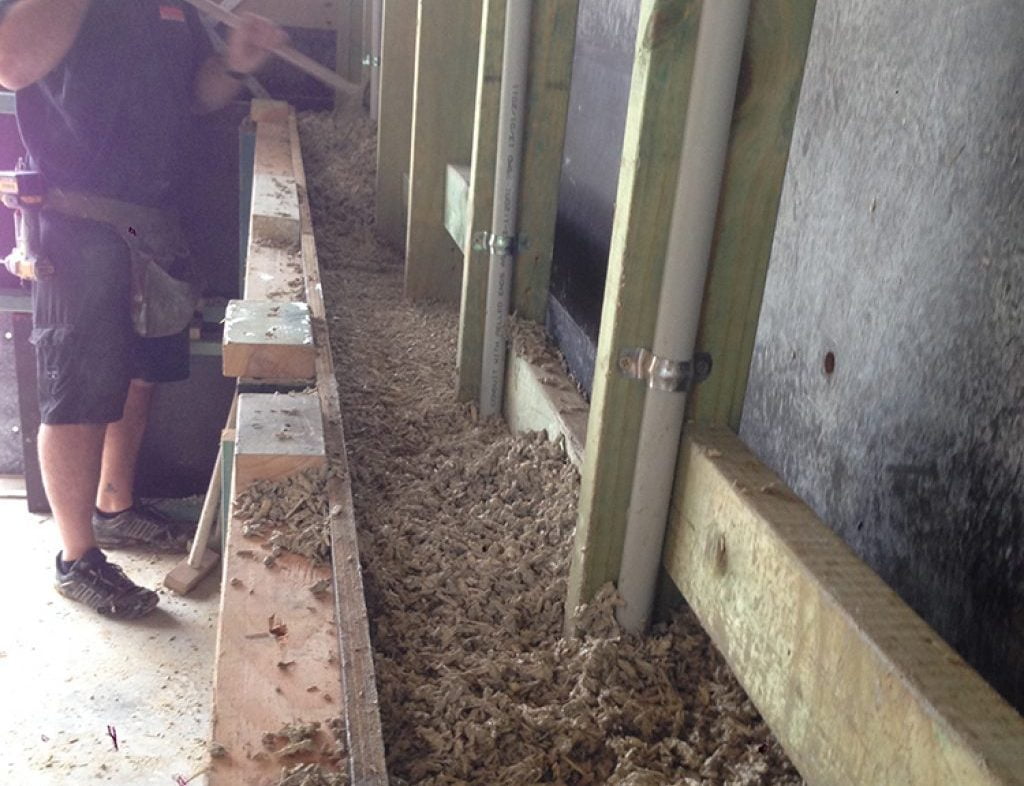
Building
The most common system so far is in situ (other methods are discussed briefly below), where formwork is erected either side of a slightly modified structural timber frame, usually with the roof already on, and the hemp lime mix is placed and lightly tamped down. The timber wall frame is fully compliant with Australian Standard 1684 Residential Timber Framed Construction, but has some subtle differences to a standard frame, such as the noggins between studs being aligned vertically to allow the mixed hurd to be placed all around, and lintels and bracing installed with a few special tweaks to facilitate placement and eliminate cracking. The alkalinity of the hydrated lime in the binder also means uncoated steel is to be avoided.
The tamping is nothing like the ramming in rammed earth, though in other ways the two processes share some similarities – here it is simply to remove air pockets. It is important to maintain some interstitial spaces (small air gaps between particles) as this aids the insulation value. It is placed in the formwork in layers about 150mm deep, and then tamped lightly down with a natural uniformity – more on that below.
The mix of hurd, lime and water, and possibly some added fine sand for increased strength and thermal mass, must be carefully controlled, as is the case in any chemical reaction. Too much or too little water, and the mix will not behave the way it should. It is important to note that this is precisely the same as mixing concrete: too wet or too dry and the strength will not be achieved. For this reason, it is important that good site management processes and a controlled storage regime is in place, especially with regard to keeping materials dry, so that a precise percentage of added mix water gives the right result. This is also part of the reason most hemp builders put the roof on first (as Noddy once suggested to Big Ears, when building Noddy’s house in Toytown) – it keeps the walls dry, and provides a shady all-weather workspace.
One of the key differences between conventional Portland cement-based materials like mortar or concrete and hemp masonry, is its base chemical reaction. Cement and concrete together make up one of the two largest carbon dioxide emitters, producing about five per cent of total human emissions. In contrast, hemp absorbs and stores carbon, even more than the lime component’s production energy emissions.
The lime is often referred to as the binder, and for most commercial applications in Australia, is a proprietary mix of materials researched and designed specifically to enhance strength, workability and overall performance.
There is no such thing as a free lunch: hemp building is not cheap building, unless the labour comes for free. We generally compare it to well-insulated brick veneer, or full brick construction. But you get what you pay for – a well-built hemp building is superior in almost every way to its conventional predecessors. But a note of caution: if you want to use volunteer labour, they should all attend a weekend training workshop beforehand. This will ensure everyone on site has a basic knowledge and consistency of technique, and reduce the risk of poor workmanship. If this seems like an impost, ask yourself – would I ask untrained volunteers to lay bricks?
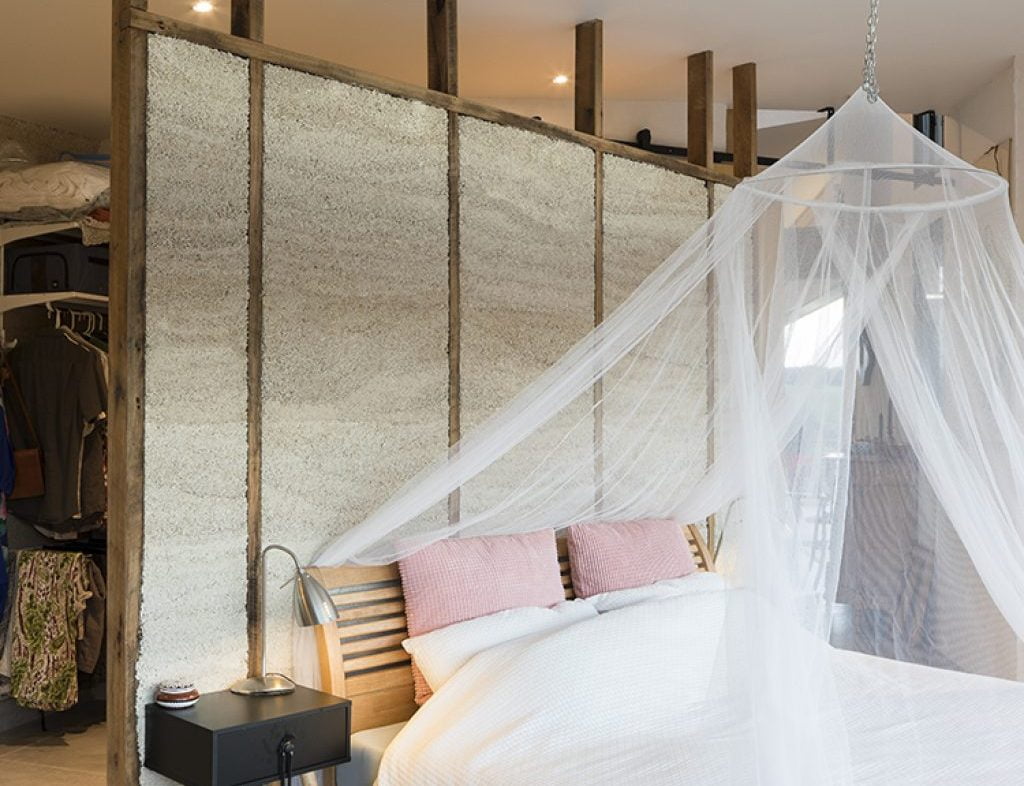
Living in a hemp house
This is (finally) where it gets really exciting! As if all of the other reasons aren’t sufficient, it’s how hemp masonry performs in a building that is the real reason so many of us are so enthusiastic. It is thermally efficient – it controls heat flows through the wall; it is breathable – it moderates internal humidity; it is non-flammable – it is safe and code compliant in cooking spaces and bushfire zones; it is long-lasting – provided the detailing and construction quality is good, and if maintenance is carried out, as in any building type, it will last hundreds of years.
The thermal efficiency is more than adequate for the full range of Australian climate zones, simply by varying the wall thickness to suit. In warmer tropical and sub-tropical zones, 200mm gives a very workable R2.1 level of insulation. In immediate coastal NSW and Western Australia, a minimum of 250mm provides a nominal R2.8. In Victoria and NSW away from the beaches, 300mm gives a useful R3.4. These are what we work on as minimums, and can always be increased to further enhance performance, but in practice it’s always best to then concentrate on high performance glazing to improve overall comfort and reduce energy bills.
But of course, maintaining a comfortable temperature is only one component of healthy living. Keeping humidity levels down is one of the other critical factors, and in this, hemp masonry stands head and shoulders above every other wall construction system, bettered only by a continuously running heat recovery ventilation system. Houses tend to accumulate internal humidity, just by us living in them: breathing, cooking, showering, perspiring – it all goes into water vapour, which is at great risk of condensing on the inside of cold walls, and in most construction systems cannot escape quickly enough to prevent the risk. It is always trying to escape, because like all imbalances in nature, it is attempting to balance the internal and external water vapour pressure. Hemp construction, by virtue of its materials and micro-structure, allows water vapour to pass with little resistance, whilst remaining effectively air-tight. It’s a neat trick, and it plays out into the most beautiful and naturally comfortable living spaces.
Finishes and aesthetics
The default finish for hempcrete is render, and this is a must externally, to provide a rain skin. The render must also be breathable, so as not to inhibit the inner workings of the hemp. Normal cement render must not be used – it is too brittle, non-breathable, and will peel off very quickly. Suitable lime-based renders, which are fully waterproof yet breathable, are available from suppliers such as Australian Hemp Masonry Company, Ozhemp and Rockcote. The texture can be varied to suit taste, as can colour.
However, many people fall in love with the rich organic colour and texture of the hemp masonry as it comes ‘off form’. It has a subtle naturally variegated pattern that follows the layers of placement, which can be enhanced with the addition of mineral oxides in the mix. Other objects can also be placed in the wall against the formwork, to be revealed when it is stripped, with spectacular results. The minor reduction in R values can be forgiven when looking at such things! Off-form is generally sealed to prevent surface crumbling or minor damage using a breathable product like Waterglass.
It is worth noting that one of the most spectacular renders is commonly called Moroccan or Venetian (as made by Rockcote). It’s smooth like glass with beautiful variegated subtle colour swathes and speckles and is entirely suitable for finishing hemp walls in wet areas. It requires an artisan renderer, and is thus a bit more expensive per square metre, but in limited areas may still fit the budget. It’s also inherently ‘groutless’, which is always nice on cleaning day.
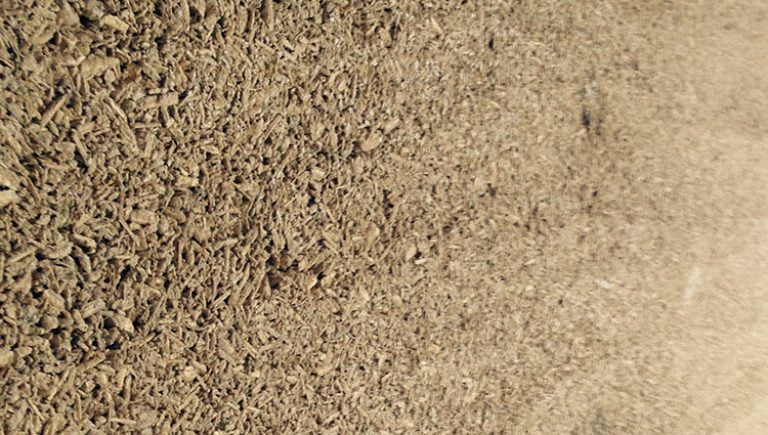
Other construction methods
Human inventiveness means people are always trying something new – can it be done better, cheaper, faster, in combination with this or that material, and so on. SIPs have attracted a lot of attention (see Sanctuary 41). Using various combinations of external skins, mostly magnesium oxide sheets, for their breathability, we are gradually evolving high-speed construction systems that are practical and affordable.
In the UK, precast hemp-lime blocks have been in production for a few years. An area of research yet to be fully explored is how to accelerate the curing process without the use of inorganic materials or chemicals. A light mix of binder and hurd without sand can also be used as ceiling or bulk infill insulation, though its R-vale per unit of thickness is somewhat less than the more common materials.
A commercial future
Oh for a crystal ball! But of three things we can be sure, apart from death, taxes, and that country music will always be awful4:
- The world is moving to a low carbon economy, where energy-intensive materials will cost a lot more;
- Consumers and regulators will always raise the bar on house performance;
- Regenerative farming will become the norm in Australia and the world, because the industrial farming methodology is already failing, and the agri-materials business is a component of that.
In the meantime, people in Australia and New Zealand have the opportunity to literally grow a regenerative building materials industry, which is still in its relative infancy, but looks set to become a major player in the future of our reinvented economy.
Hemp hurd and binders are currently available from two suppliers. The supplier of Australian grown and produced hemp building materials is Australian Hemp Masonry Company (AHMC), and Ozhemp supplies both locally grown and imported building grade hemp and lime binder specifically formulated for hempcrete building, certified through CodeMark5.
References
1 This article only discusses the use of the industrial hemp plant, which has virtually no THC – the famous, or infamous ingredient of marijuana – and does not discuss the newly legalised medicinal uses of its high-THC cousin plant.
2 A new book “Call of the Reed Warbler” by PhD-holding farmer Charles Massy has dozens of case studies from here and overseas, of farms and farmers who are doing amazing things in the full range of climate zones and soil types.
3 Karus and Leson, 1994
4 You can blame Shaun Micallef for that comment, and while it may often be true, be it known that it ain’t always, ain’t always, no baby not always the waaayeee. I do not expect this footnote to survive my Dear Editor’s razor. [Wrong again DC. Ed]
5 Certification through the Australian Building Codes Board.
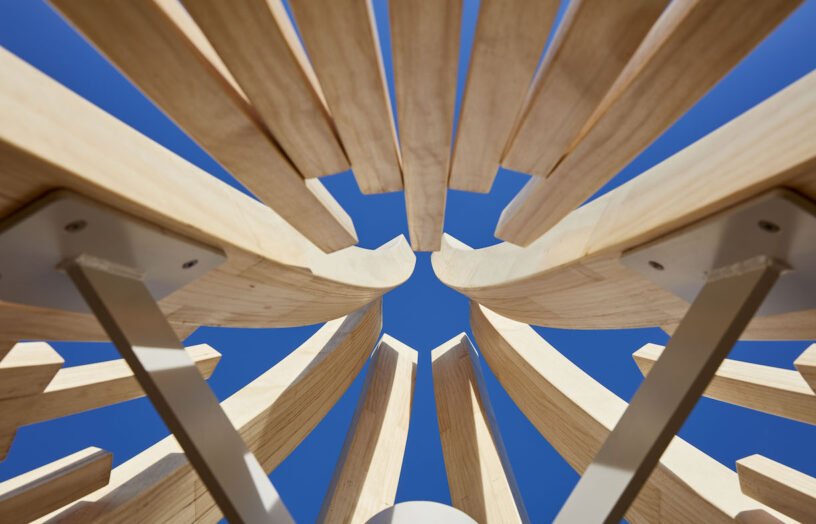 Ideas & Advice
Ideas & Advice
In praise of Accoya
Native hardwoods are beautiful, strong and durable, but we need to wean ourselves off destructive forestry practices. Building designer and recreational woodworker Dick Clarke takes one hardwood alternative for a test run.
Read more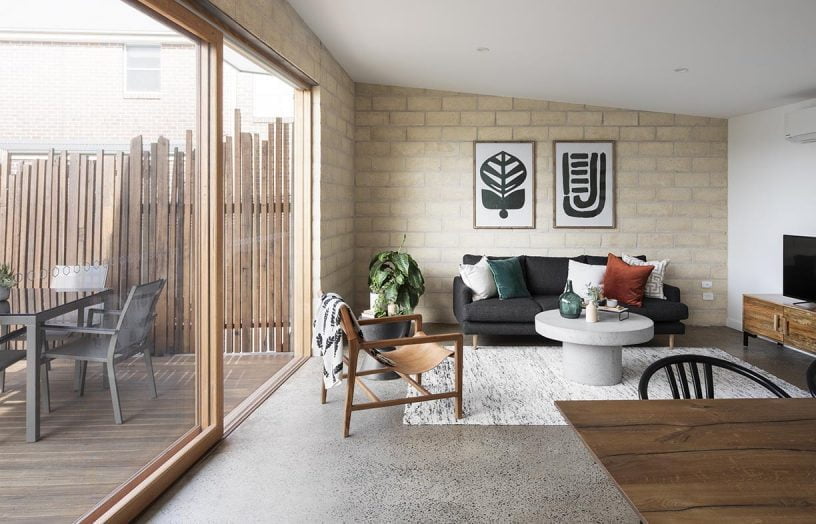 Ideas & Advice
Ideas & Advice
Eco-concrete case studies
Adored for its thermal mass benefits and durability, concrete remains one of the most popular building materials in the world, but its shockingly high embodied carbon footprint cannot be ignored. Luckily, there are now a number of greener alternatives available. Jacinta Cleary examines how they have performed in three different homes.
Read more


